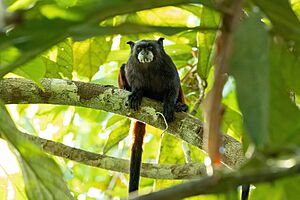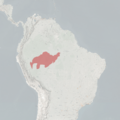Brown-mantled tamarin facts for kids
Quick facts for kids Brown-mantled tamarin |
|
|---|---|
 |
|
| Conservation status | |
| Scientific classification | |
| Genus: |
Leontocebus
|
| Species: |
fuscicollis
|
 |
|
| Approiximate range of the Brown-mantled Tamarin | |
The brown-mantled tamarin (Leontocebus fuscicollis), also known as Spix's saddle-back tamarin, is a small monkey. It's a type of saddle-back tamarin. This New World monkey lives in South America. You can find it in countries like Bolivia, Brazil, and Peru.
It eats both plants and animals, making it an omnivore. These monkeys live in small groups, usually with 4 to 15 members. They talk to each other using sounds and by smelling things. The brown-mantled tamarin is currently not considered in danger of extinction. However, its numbers are going down because of poaching, losing its home, and being caught for the illegal pet trade.
Contents
What is a Brown-Mantled Tamarin?
The brown-mantled tamarin is a small primate. It has a body length of about 8 to 9 inches. Its tail is long, measuring 5 to 12 inches. Males and females look very similar.
These tamarins usually live for 8 to 13 years. Some have lived up to 25 years in zoos. They have orange-yellow fur with black patches. Their narrow hands help them reach into small spaces to find food. These monkeys are active during the day (diurnal). They spend most of their time in trees (arboreal).
Where Do They Live?
Brown-mantled tamarins live in a large area of the northern Amazon River Basin. Their home is in South America, mainly in Brazil, Peru, and Bolivia.
They prefer to live in lowland tropical forests. These can be forests that have never been cut down or ones that are growing back. Brown-mantled tamarins usually stay in the lower parts of the tree canopy. This is different from some other monkey species.
Sometimes, they share their home with other animals. For example, they live in the same areas as pygmy marmosets. They might even visit the holes pygmy marmosets make to get tree sap. They also sometimes hang out with red-bellied tamarins.
What Do They Eat?
Brown-mantled tamarins are omnivores, meaning they eat both plants and animals. Their diet includes:
They especially like tree sap during the late dry season and early wet season. To get sap, they often use holes already made by other monkeys, like the pygmy marmoset. They usually don't make their own holes.
How Do They Behave?
Social Life
Brown-mantled tamarin groups usually have about 8 monkeys. They sleep in low palm trees or hollows in trees. They hide to protect themselves from predators. Their territory can sometimes overlap with other monkey species. These include the pygmy marmoset, Goeldi's marmoset, and moustached tamarin.
Tamarins often defend their territory. However, not all meetings between groups are aggressive.
How They Communicate
Brown-mantled tamarins use different sounds to talk to each other. They have a soft trill for contact. They also have a loud whistle for long distances. An alarm call warns others about danger. These calls can sound like chirps or whistles.
They use alarm calls when they sense danger. Other group members respond to these calls. This helps them know where everyone is. Since their territory often overlaps with other monkeys, different species might even respond to their calls.
Scent Communication
These monkeys have a very good sense of smell. They have special glands that produce scents. They use these scents to mark their territory. They can also tell things like species, sex, and who an individual is from these scents. Female tamarins can even show if they are ready to have babies through their scent.
Scent marks stay on branches or trees for a long time. This is different from sounds, which disappear quickly. Scent marking helps them communicate with other groups. It can help reduce fights when territories overlap.
Scent marking also helps with reproduction. Females release special scents (pheromones) to attract a mate. Males might put their own scent over a female's scent. This can be a way to show that she is his mating partner. Sometimes, they even put scent on other monkeys.
Reproduction and Family Life
Brown-mantled tamarin groups usually have one female who has babies. There are often two or more adult males. It's common for the dominant female to give birth to twins. All members of the group help take care of the babies.
Because twins are common, it can be hard for the mother to care for all her babies alone. So, other monkeys in the group help out. This is called alloparenting. Males who are not the father also help. The breeding male usually carries the babies until they are about 90 days old. He only passes them to the mother for feeding.
The mother is pregnant for about 150 days. Babies drink milk from their mother for 3 to 4 months. They become adults around 2 years old.
Conservation Status
The brown-mantled tamarin is listed as a species of Least Concern by the International Union for Conservation of Nature (IUCN). This means they are not currently in danger of extinction.
However, their population is slowly decreasing. They face threats like:
- Loss of their home due to logging
- Forests being cleared for farming
- Poaching
- Being caught for the illegal pet trade
Images for kids




